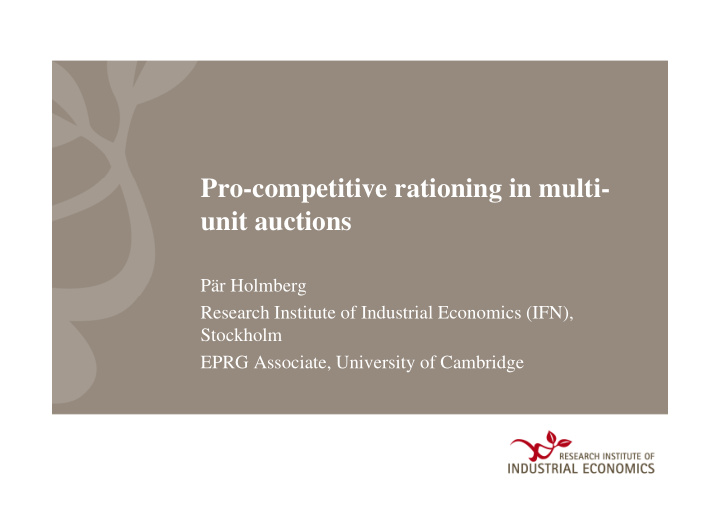



Pro-competitive rationing in multi- unit auctions Pär Holmberg Research Institute of Industrial Economics (IFN), Stockholm EPRG Associate, University of Cambridge
Multi-unit auctions Each year multi-unit auctions trade divisible-goods worth trillions of dollars, for example in wholesale electricity markets and treasury bond auctions. How can competitiveness of such auctions be improved? I consider a procurement auction, where each producer submits a stepped supply curve. Price Supply curve Quantity
Rationing The market is often cleared in the middle of a step. Price Aggregate supply Marginal volume Clearing price Excess supply Infra-marginal volume Auctioneer’s demand Quantity
Rationing methods in prior-art • Pro-rata on the margin rationing: Completely accept infra-marginal volume. Ration marginal volume proportionally; each bidder gets the same share of its marginal volume accepted. Often used in single round auctions. • Time-priority: Completely accept infra-marginal volume and give early marginal bids priority to late marginal bids. Often used in financial exchanges. • Kremer & Nyborg (2004). Proportional rationing of both marginal and infra- marginal bids => Can sometimes improve competition, but it often introduces efficiency problems. • Gresik (2001) and Saez et al. (2007) introduce various rationing rules, where rationing is disproportionate and infra-marginal volumes are often completely accepted. • Simon and Zame (1990), Jackson and Swinkels (1999) analyze rationing rules from an existence perspective.
Influence of rationing rule Field and Large (2012) empirically observe that rationing rule (time priority or pro-rata on the margin) influences bidding behaviour in financial exchanges. Rationing rule matters more when volume of marginal bids is large relative to infra- marginal volume, as in security auctions, financial exchanges and frequent batch auctions.
New rationing rule • Infra-marginal volume is completely accepted. • Disproportionate rationing on the margin. • Rationing rule depends on clearing price.
Pro-competitive rationing New rationing rule makes bidding more competitive; producers provide commodity at lower price. Max supply Reservation price Price Encourage small volume Supply Encourage large volume Quantity New rationing rule gives producers with large marginal volumes priority at low prices and producers with small marginal volumes priority at high prices.
Model: new rationing rule 1) Accept all infra-marginal bids. 2) Accept marginal bids little by little. Each increment in the accepted volume is split according to the following rule: j Excess supply i producer i' s share N j Excess supply k k 1 3) Disproportionality of the rule is determined by μ j , which depends on the clearing price. Maximum priority t o bidders with large excess supply at lowest price 1 0 Maximum priority t o bidders with small excess supply at highest price M j decreases with such that competitio n is boosted by the same factor j at each price level
Model: Bidding format Max supply Reservation price Price v price levels are fixed by auction Supply design Supplier’s choose quantity at each price Quantity level Similar to Holmberg, Newbery and Ralph (2013)
Theoretical model: SFE assumptions Consider uniform-price auction with N producers Auctioneer’s demand is uncertain. It is announced ex-post. Costs are common knowledge. One shot game. Solve for Nash equilibrium where each producer maximizes its profit given supply functions of competitors. SFE assumptions (Klemperer and Meyer, 1989) have been empirically verified (Hortacsu and Puller, 2008; Wolak, 2007).
Result for optimal rationing rule Optimal rationing gives auctioneer approximately same total procurement cost as an auction with standard rationing and (1+1/( v- 1)) (N- 1)+1> N producers with same total production cost. Pro-competitive effect is larger when bids accumulate at a few price levels, v . If producers bid at only two price levels, introducing pro-competitive rationing is equivalent to increasing the number of producers from N to 2( N -1)+1.
Example with two price levels 10 Aggregate supply curves Pro-rata, 3 firms Pro-rata, 2 firms Optimal rationing, Price 2 firms 5 Aggregate marginal cost 0 0 0.5 1 Total output relative to total production capacity
Reverse ascending bid auction Bid price increments tend to get denser towards the clearing price in clock auctions and other multi-round auctions where bidding starts at the reservation price. Price Reservation price Aggregate supply Clearing price Auctioneer’s demand Quantity In comparison to standard rationing, auctioneer’s payoff is larger if the rationing rule gives small marginal volumes maximum priority at all price levels. But an optimal rationing rule, where rationing depends on the clearing price, is even better.
Conclusions Optimal rationing rule is disproportionate and depends on the clearing price. Optimal rationing rule gives producers with large marginal volumes priority at low clearing prices and bidder’s with small marginal volumes priority at high clearing prices. Pro-competitive rule has larger effect when bids accumulate at a few prices. Under beneficial circumstances, an optimal rationing rule has the same effect as a doubling of the number of bidders. In clock auctions and similar multi-round auctions, competitiveness is improved by simply giving maximum priority to small marginal volumes at all price levels.
Recommend
More recommend